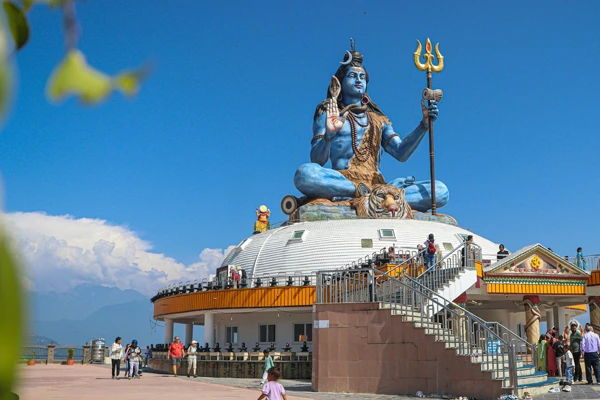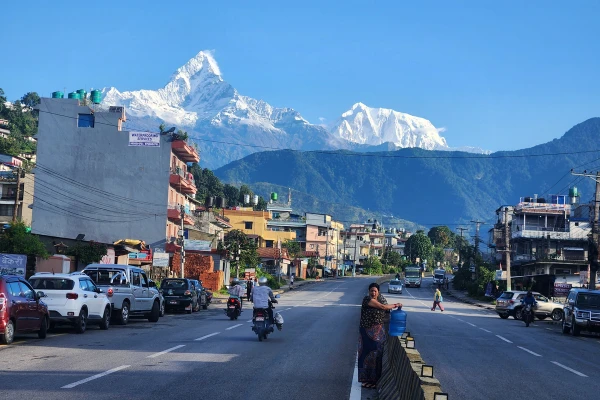Planning to trek to Everest Base Camp in 2025? This comprehensive guide covers everything you need to know about the required trekking permits, including costs, where to obtain them, and why they are essential. From the Sagarmatha National Park Entry Permit to the Khumbu Pasang Lhamu Rural Municipality Entrance Permit, ensure you're fully prepared for your adventure in the Himalayas.
Everest Base Camp Trekking Permits: What You Need to Know for 2025
Table of Contents
The EBC, Everest Base Camp, is one of the most popular trek destinations around the world, showing the thrilling adventure journey into the altitudes of the Himalayas. In planning for this year's 2025 EBC Trek, one good thing that can be done is first learning about these permits. As we have seen, these are not mere paperwork but very crucial to uphold the integrity of the region and the locals, and offer safety throughout your trek. Here, you will find all the information you might need about the permits you are to obtain, their prices, as well as the sources where it is possible to get them, and much more.
Permits Needed for the Everest Base Camp Trek
Preparing for the Everest Base Camp Trek involves knowing, in detail, the permits that will be required for your trip. Presently, there are two compulsory permits for the basic EBC trek and, depending on the chosen track, one more.
- Sagarmatha National Park Entry Permit: This permit is for the entrance into the Sagarmatha National Park; this is a protected area and a world heritage site. Mount Everest also falls within this park, along with a bewildering variety of plant and animal life endemic to the area. The fee charged for the permit is for the enhancements of the conservation, the maintenance of the trails within the area, and the protection of natural resources within the park.
- Khumbu Pasang Lhamu Rural Municipality Entrance Permit: This is a newly put permit to regulate the flow of tourism in the Khumbu area and is obtained from the authority. This was the new facelift of the previously demanded chit known as the Trekkers' Information Management System, or TIMS card, for this area. This permit generates funds that are used in infrastructure development, facilities development in the Khumbu area, and expenditure on waste management and conservation.
- Gaurishankar Conservation Area Permit (Optional): If your trekking starts from Jiri or will pass through the Gaurishankar Conservation Area, it is an additional permit requirement. That is a funny conservation area, not that popular with tourists, an excellent chance to see some unique fauna and flora with historical landmarks.
Detailed Everest Base Camp Trek Permit Price Breakdown
If you are planning your trek, then you need to know the costs that correspond to each of these permits. These fees vary depending on the national origin and the area that one plans to cross.
- Sagarmatha National Park Entry Permit: International Trekkers: NPR 3,000 per person (equivalent to USD 25-30). This fee is rather immutable and does not depend on the season, unlike other centers.
- SAARC Nationals: It costs NPR 1,500 per head, around USD 12 to15. The trekkers from the South Asian origin are charged a relatively lesser amount compared with the international trekkers, thereby making it accessible for them to get this fascinating region of the world.
- Khumbu Pasang Lhamu Rural Municipality Entrance Permit: All Trekkers (International and SAARC): In every household at least NPR 2,000 or approx. 15-20 USD. These fees are charged uniformly for trekkers of all the nationalities interested in this country. This means that the permit is good for the whole period you shall be trekking within the Khumbu area.
- Gaurishankar Conservation Area Permit (If Required): All Trekkers: Approximately NPR 3,000 (US dollars 25-30) per person. This permit is however only required if you will be trekking in the region that covers the Gaurishankar Conservation Area. It is compulsory for the people who begin their trek from Jiri or any other less conventional beginning points of the Everest trekking area.
The point that needs to be mentioned here is that all these fees are non-refundable and have to be paid in Nepalese rupees (NPR). It is advisable to have as much local currency as possible, especially if you are to obtain your permits from other parts of Nepal than Kathmandu.
Where and How to Obtain Your Everest Base Camp Trekking Permits
Acquiring the permits is equally easy; however, the details of where and how to start to get the permits should be well understood to ensure a smooth process. Currently, it is possible to get the necessary permits either in Kathmandu before the start of the trek or in the Everest region directly.
In Kathmandu:
Nepal Tourism Board Office: Both the permits can initially be issued from the office of the Nepal Tourism Board in Bhrikutimandap, Kathmandu first the Sagarmatha National Park entry permit and the Khumbu Pasang Lhamu Rural Municipality entrance permit. It opens from Sunday to Friday, starting from 9:00 in the morning up to 4:00 in the afternoon. You can also get the Gaurishankar Conservation Area Permit here if needed, depending on your track. However, this is something your trekking agency will arrange for.
DNPWC:
This is in the physical address of Babar Mahal, Kathmandu, and apart from other functions, it issues an entrance permit for Sagarmatha National Park. Here, the procedure takes too little time, as well as social services, well enough, with caring staff there in your help to fill up applications.
In the Everest Region:
Lukla: The Khumbu Pasang Lhamu Rural Municipality Entrance Permit is purchased at the authority in Lukla for trekkers who want their permits as close as possible to the trekking start.It is very useful, particularly for those who have chartered a flight and land directly in Lukla eager to start their trek.
Monjo: The Sagarmatha National Park Entry Permit can also be attained from the entry point in Monjo, which is one of the most popular checkpoints while entering the Sagarmatha National Park. This option is perfect for people who would prefer to organize their permits on the way to the trail.
For those starting their trek from Jiri or passing through the Gaurishankar Conservation Area, you can obtain the necessary permit at the Nepal Tourism Board office in Kathmandu or at the checkpoint in Shivalaya, en route to Jiri.
Changes and Special Considerations for the 2025 Trekking Season
The trend of the trekking industry can vary from year to year, and the scenario of the year 2025 may not be the same as observed in previous years. Following are some facts to consider for the new season along with new updates that you should know for the new trekking season.
- No TIMS Card Required: Every trekker who trekked in Nepal was supposed to have a Trekkers' Information Management System or TIMS card. However, from 2025, there is no need for the TIMS card when trekking through the region of the Everest Base Camp. Actually, there is a new entrance permit known as Khumbu Pasang Lhamu Rural Municipality Entrance Permit, and the TIMS card here has been well done. But you can find that if you are to trek in other areas in Nepal, a TIMS card might still be necessary.
- Permit Validity and Duration: Permits usually accompany you for your entire trek; they are normally issued for the time spent on the trek only. But it is recommended to clarify the validity of the permits that you have in case you are planning to be in the region for weeks or so. Unauthorized overstay is also prohibited, and it attracts some penalties or fines, which therefore makes it a no-go area if one’s permit has exceeded its validity.
- Carrying Multiple Copies: As a measure of precaution, it’s always wise to have several copies of each permit on you. Your permits will be checked at the different check points on the trekking route, and carrying extra copies is wise since one can easily be lost or damaged. Moreover, during the time of registration, some of the lodges may ask you to present a copy of the permit you were issued.
- Currency and Payment Options: The larger offices in Kathmandu may possibly let you pay with a credit card, but there are relatively smaller offices that deal with issuing the necessary permits in the Everest region, and it’s improbable that they would be able to accept anything other than cash, specifically in NPR. This is because in the deposits, there are rarely any ATM machines; hence, it is advisable to ensure one has sufficient cash for the permit fees.
Additional Permits for Alternative Routes and Climbs
The two basic ones are the Sagarmatha National Park Entry Permit and Khumbu Pasang Lhamu Rural Municipality Entrance Permit, for most trekkers heading to EBC will be obliged to avail of these requirements; although there are still other permits that may be necessitated for if one has to make a different choice of route or even have to ascend on some pinicles at the area in question.
Island Peak Climbing Permit: For trekkers who have a desire to go up to Island Peak or Imja Tse, then the climbing permit will be needed. Island Peak is a trekking peak located close to the village of Dingboche, and doing Island Peak entails an extra day and view for the EBC trek. The cost of the climbing permit is different according to seasons:
- Spring (March to May): $250 Usd per person
- Autumn(September to November): $ 125 Usd per person
- Winter(December to February ) and Summer(June to August): $ 70Usd per person
- Lobuche Peak Climbing Permit The other popular peak in the Everest region is Lobuche east. If you want this climb to be included with your trek, a different climbing permit is necessary to obtain
- Spring (March to May): $ 250 Usd per person
- Autumn (September to November): $125 per person
- Winter (December to February) and Summer (June to August): $70 per person.
Such additional permits are available from the NMA in Kathmandu or through any registered trekking agency that arranges peak climbing expeditions.
The importance of permits: conservation, safety, and regulation
The permits needed for Everest Base Camp Trekking are not mere formalities or legal formalities; they’re conservation tools for the region, safety frames for the trekkers, and economic benefits for the locals. Here’s why these permits are essential:
- Environmental Conservation: This means that money that is generated from the Sagarmatha National Park Entry Permit is utilized in the preservation of the park. This involves the preservation of wildlife, especially the endangered species, the preservation of the integrity of the forest, and also preventing accidents for the trekkers on the trails. Lack of such funds poses a threat to the environment in the park owing to a one-time mistake with long lasting effects.
- Local Communities' Revenue: That is, money collected from the Khumbu Pasang Lhamu Rural Municipality Entrance Permit Fee is invested into infrastructural construction within that municipality, including roads and schools, and even into health facilities. The number of trekkers in those areas exerts much strain on the resources there. Permit fees are charged against the trekkers, which will help raise contributions to the local people.
- Safety and Regulation: They also help in controlling the number of tourists who practice trekking, hence enhancing safety and also taking care of the environment. The authorities are able to control the traffic, identify the possible problems, manage the potential emergencies, and avoid trekkers’ overcrowding, which can be dangerous for the people or have a negative impact on the environment.
Conclusion: Get Ready for Your Everest Base Camp Trek in 2025
If going to the Everest Base Camp in 2025, then getting permits should be on number one on your list. With these permits, you shall adventure and trek in some of Earth's most stunning scenery, safe in the thought that you are doing it in a sustainable, lawful, and positive way with the environment and people around it. Ensure that you have several copies of the permits you may need and will have budgeted for the fees when the time comes to make the trek; ensure that you are updated on any new changes that may govern your trek when the time comes. Have a safe trip and have fun on the roof of the world.

.webp)



